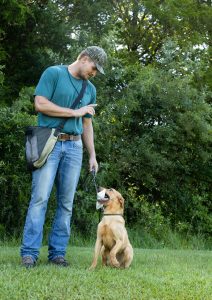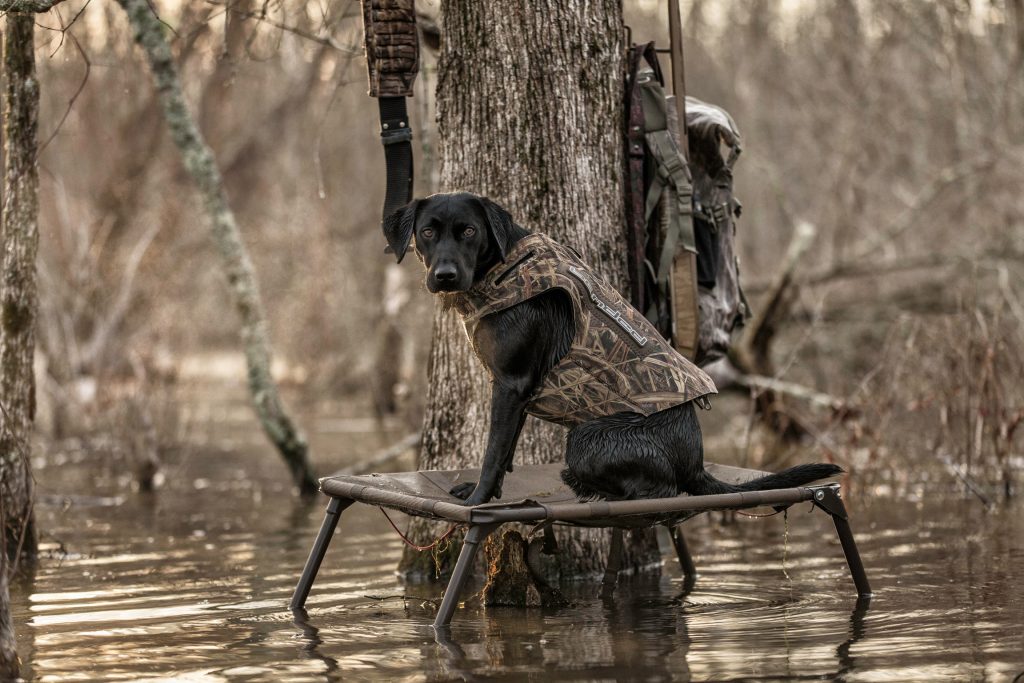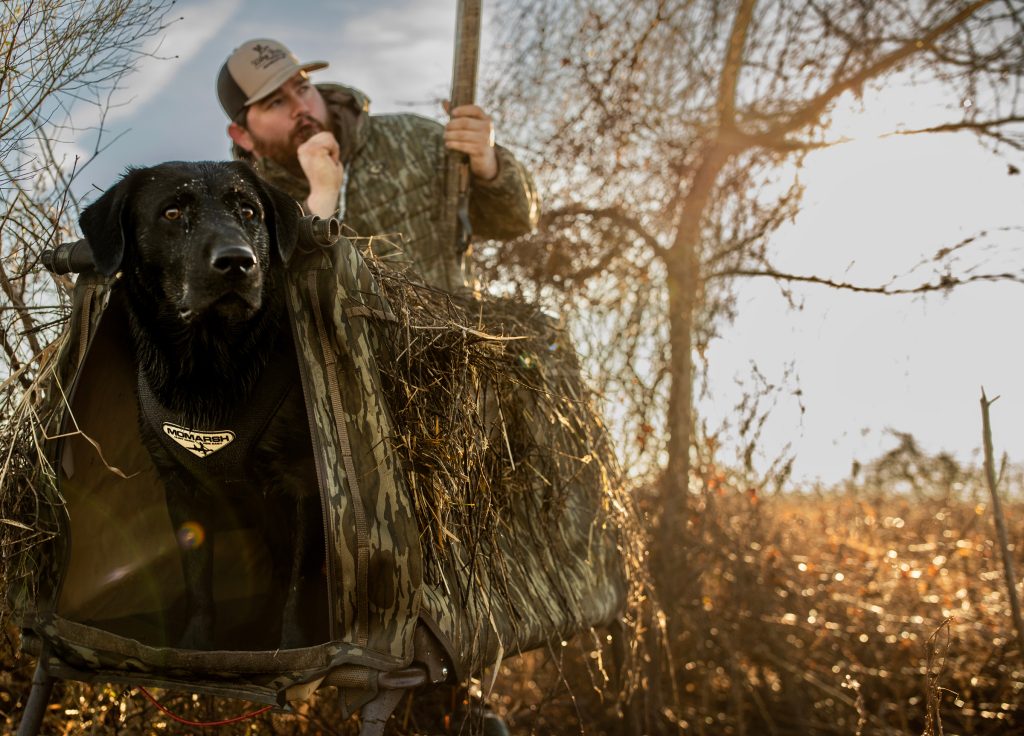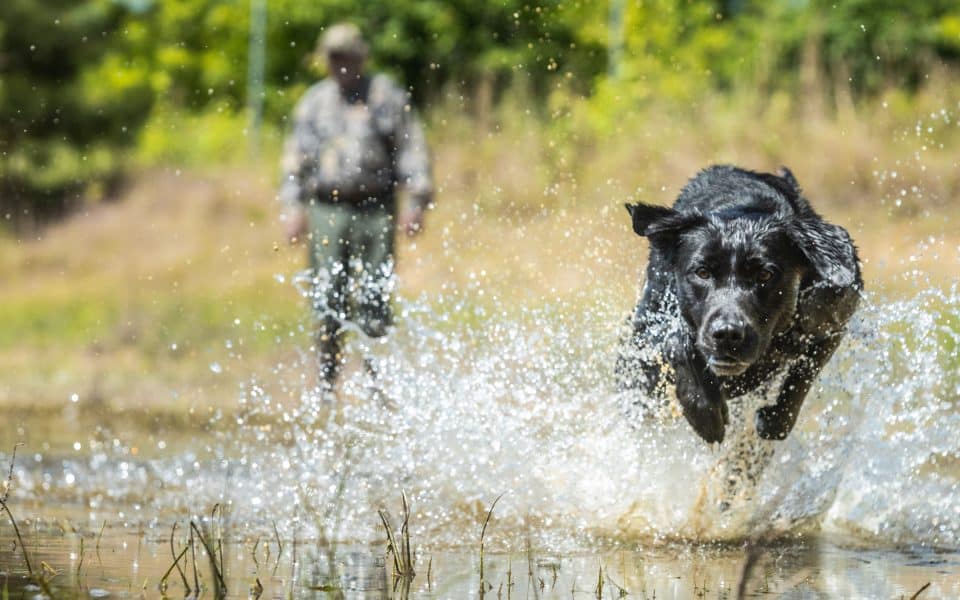Transitioning Hunting Dogs from Land to Water
I have had many discussions with people regarding their dog’s transition from land to water, a critical step in hunting dog training. Most of the folks were having trouble getting their pup to handle on water. To evaluate the problem and offer a solution, I had them demonstrate how they handled their dog on land, and in almost every instance, I immediately knew what the problem was — the pup was not handling well on land either. The pup was at times ignoring the stop whistle and not always properly responding to hand signals.
My immediate question was, “Why would you expect the dog to handle on water when they don’t handle properly on land?” I then explained that the underlying problem was that they expected too much out of their dog in too short a period of time, and they moved onto advanced training long before the dog was anywhere near ready. To put it another way, they had not laid a firm foundation on land before attempting to handle on water. As always, I reminded them that “haste makes waste” or in other words, they were pushing the dog too hard and too fast and cracks were beginning to surface in the dog’s foundational training.
Prerequisites to Handling in Water

Mossy Oak
Foundational Hunting Dog Training
Puppy training starts the day you take your new pup home. This early socialization and training must form a solid foundation upon which both intermediate gundog training and advanced gundog training can be built.
During this early training, pup is exposed to all the basics including sit, stay, recall, and lead work (walking at heel). The dog should not be allowed to jump on people or play bite. Other annoying habits should be discouraged as well. They should learn to focus on you and the task at hand and to ignore their surroundings. To produce a confident, happy, stress-free, and obedient dog (without emotional baggage), expose them to as many people as possible and to other dogs on a daily basis. The socialization process is vital to normal development and their future success as they develop into a working gundog.
During the next phase of training, all the commands taught in the foundational training phase are reinforced. The pup is taught to walk on and then off a lead, to recall, to sit in place and remain in place until released, and to remain steady (stay in the face of distractions from thrown dummies, other dogs, gunfire etc.), and introduced to basic retrieves. Also, you must increase your dog’s focus on you and you should be learning to read their body language. Rest assured they are at the same time reading your body language and learning from it, albeit good or bad.
Advanced Hunting Dog Training
Finished gundog training normally begins at about eight months. This training consists of multiple retrieves, directional retrieves, lining, stopping on the whistle, taking left, right and back cast, working through barriers, working through and eliminating thresholds, and being quiet during the hunt. You would also consistently work on steadiness between each step. By this time, you have probably guessed that I am a huge fan of steadiness and quietness in the blind, you are correct. To me, these are two of the most important attributes of a great gundog and much attention must be devoted to these areas during every training session.
As you progress, adjustments may have to be made because not all dogs are the same; and what takes one dog a day to learn may take another dog two, three or four days or more. So start with building a good solid foundation and make adjustments to the training steps as necessary.
To assess a dog’s level of development during training takes really good observational skills and an honest assessment of the dog’s abilities. What should you be looking for in the dog’s performance? We are looking for skill sets that the dog has mastered, including all the traits mentioned in the preceding paragraphs. Once the dog is proficient at all the above on land, they are ready to move onto water work, but not until then.
Introducing Your Hunting Dog to Water
Early Water Training for Hunting Dogs
Your dog should be introduced to water at an early age. Introduction to water should not be attempted when the water is too cold or too deep. At this stage the goal is to make the pup’s introduction to water a pleasant experience so they don’t become fearful of water. If they don’t eagerly enter or refuse to enter the water, don’t get overly aggressive and throw them into the water. This misguided effort on your part will simply increase their reluctance to enter the water and swim.
Instead of this misguided approach, at the beginning, on a warm day, find a shallow spot in a pond where your pup can walk/wade but will not have to swim. Put on your boots, wade a short distance out in the shallows and call them to you. They may be reluctant at first. When they decide to wade out to you offer lots of praise and encouragement. In the next session(s) move out a little deeper each time until your pup has to swim a short distance. Repeat this scenario until they are comfortable getting into the water and swimming. This may happen during the first session, or it may take several. Only after you are satisfied that your pup is at ease in the water is it time to move on.

Mossy Oak
Once your dog has satisfactorily completed all phases of handling on land and has satisfactorily completed basic water training, they are ready for advance training on water. This includes land-water, land-water-land, casting left-right-back, and water blinds. Again, at the risk of repeating myself, you cannot handle them on water if they do not handle first on land.
Next, add a training dummy to the mix and have them make short water retrieves. Increase the distance as they gain confidence or until the pup is making retrieves at a distance that you are satisfied with. A word of caution, do not test them in water with retrieving feats that they would not be comfortable making and have not progressed far enough in his/her training to make.
Instead of trying to impress yourself and your buddies with your dog’s abilities, progressively train the pup in the water. Remember never to fall into the trap of attempting to handle them in the water until they can be handled on land. If your pup will not handle on land, he/she certainly will not handle on water, and timely corrections are difficult to make on water, especially when they do not understand the commands and you are not willing and ready to swim out to discipline pup.
Training Hunting Dogs with Decoys
Decoy Introduction on Land and Water
How many times have you seen young dogs try to pick a decoy when sent to retrieve a duck on his/her first live duck hunt? I have seen it many times, and I opine that it is a direct result of the trainer failing to properly introduce the dog to decoys during training on both land and water. As soon as they have been properly steadied and are making satisfactory retrieves on land, I add decoys to the mix. Lay out a half-dozen or so decoys on the training grounds, back off a few yards, throw a dummy on the other side of the decoys and send your dog. At first a pup may stop to investigate the decoys, but this activity soon fades; and they should run through the decoys and make the retrieve. Then put out decoys in the water and repeat the retrieving sequence. As on land, the dog will normally investigate the decoys and then get on with their business of retrieving the dummy.
Water Delivery Training for Hunting Dogs
Preventing Dummy Drops in Water Training
Based on many observations over the years, I have concluded that the wrong approach to water delivery will most assuredly result in a pup dropping the dummy. For example, on a water mark, the trainer/handler stands on the bank, throws the dummy out in the water, and casts the pup from dry land. The dog enters the water, swims out, picks the dummy, and returns to the bank. Immediately upon exiting the water, the pup drops the dummy as they shake off.
What’s wrong in this scenario is that if allowed to continue dropping the dummy upon exiting the water, this uncorrected behavior will be transferred to land retrieves, and the pup will start dropping on land. As a result, a problem that could have been avoided is becoming a conditioned habit and must be corrected, in this instance by using condition hold training or at the extreme end of the spectrum force fetched.
How could this issue have been avoided? The answer is simple and should be obvious. Don’t let them start dropping the dummy. What do you need to do different in this scenario to prevent the puppy from dropping the dummy? It has been my experience that you must get in the water with them and upon return, when they can stand on the bottom of the water source and just before they exit the water, put your hand on the dummy and command “give.” As taught on land, the pup should release the dummy. Then as the pup exits the water command “shake” and the dog should shake.
By being consistent and gradually moving to the pond’s edge and incrementally increasing the distance on dry land, the pup will soon understand that their natural tendency to drop the dummy and shake should only be done when told to do so. In a few lessons the pup should fully understand that they should deliver the dummy to hand and then shake when the command is given. Through consistency and repetition in training, this too will become a conditioned habit and as they grow older, they will naturally hold the dummy, deliver the dummy to hand, and then shake.
Advanced Water Handling for Hunting Dogs

Mossy Oak
Handling Skills for Hunting Dogs in Water
At this juncture the pup is responding to whistle commands, handling very well on land, has been introduced to water, has learned to swim through decoys, has learned to hold the dummy upon exiting the water and to deliver to hand, it is time to transition to handling on water. Start with a single mark, move up to double and triple marks and unknowns and blinds. On doubles, send the dog, stop them with one blow of the whistle, they should turn and look at you, at which time you give them a right over, left over or a back command. If they ignore the command, stop them with the whistle and recast them. It won’t be long before they are handling very well on water.
Bill Gibson is the Kennel Master at Mossy Oak Kennels.
Join our weekly newsletter or subscribe to GameKeepers Magazine.
Your source for information, equipment, know-how, deals and discounts to help you get the most from every hard-earned moment in the field.









